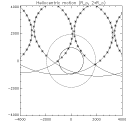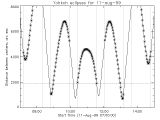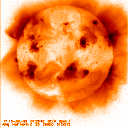
(Week 29, 1999)
See the weekly operations report for details.

In the display above (click to enlarge), the colored lines show the times of SXT images that currently are on-line at ISAS. The purple lines are flare mode. The gaps will be considerably reduced when the NASA telemetry arrives and gets reformatted.
For a summary index listing of the weekly science reports, click here. Generally, these notes contain current research, or ideas related to current research in solar physics, as revealed by Yohkoh. They are done in "real time" and so they may contain (a) jargon, (b) blunders, or (c) trivialities. Of course they are not screened by referees! We are always happy when somebody writes a paper stimulated by one of these nuggets, and it happens frequently. The SXT Chief Observers (most of the authors) do not have any proprietary rights to the data or ideas presented.
By now Yohkoh SXT is a veteran observer of X-ray solar eclipses. We have written several previous science nuggets on earlier ones, for example the eclipse of February 26, 1998. As usual, we have obtained a detailed calculation of the lunar position as viewed from Yohkoh from M. Soma of the National Astronomical Observatory (Mitaka, Tokyo, Japan). The following plots show the predictions based on orbital elements of July 13, 1999. We may be able to update the plots shown here with new elements obtained closer to the time of the eclipse. For information regarding the eclipse as viewed on the surface of the Earth, please see the NASA eclipse pages which have abundant information. As usual, Yohkoh will see several episodes of eclipse. The Moon executes a looping motion, counterclockwise in sense on our standard view (E to the left), and progressing from west to east. Because the path of totality lies in Europe, it's visible during the northerly swings of the Yohkoh orbit:

On the plot above (click to enlarge) we show the lunar location every two minutes (during sunlit portions of the Yohkoh orbit). The smaller circle in the center represents the Sun, with the larger circle at the sum of the solar and lumar radii; thus whenever the asterisks fall inside this larger circle, there's a partial eclipse as viewed by Yohkoh.
The plot below shows the same information on a somewhat less confusing diagram, namely a plot of Sun-Moon separation as a function of time. We see the same two partial eclipses and two "kisses" where the Moon will just occult part of the corona up to the solar limb.

Fortuitously, we find ourselves 27 days from the eclipse at the time of writing. Thus the image below

shows our best guess about the coronal configuration at the time of the eclipse, unless the brave theorists Mikic and Linker make another model prediction. This image shows the Sun in its lowest state of activity since late April. We see an exquisite sigmoidal interconnecting loop structure between two active regions in the SW quadrant. Also there is a huge polar-crown filament channel in the SW - it will be interesting to see if it is still there in August, supporting a mammoth helmet streamer to be admired by the eclipse-viewers strung out from Lands eND to Viskhapatnam.
H. Hudson 15-Jul-99